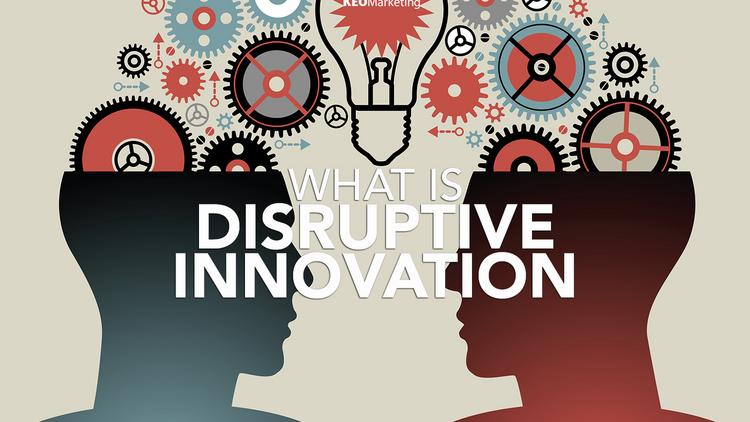Disruptive Innovation- Meaning and causes
The Merriam-Webster Dictionary defines Disruption as “a process that disturbs the normal development or movement of (something).” This meaning does not provide a positive image of Disruption, and anyone would see it in a negative sense. But from a business perspective, Disruption can have a positive connotation as well. Clayton Christensen wrote ‘The Innovator’s Dilemma’ in 1997, wherein he hosted the concept of ‘disruptive innovation.’ Innovation and disruption may create confusion as they present both represent similar ideas of creating and building. In reality, there is a thin line of differentiation between the two, in the sense that every disruption can be innovative, but not every innovation can be disruptive.
Disruption has of late become a global trend that occurs now and then, and hence various business organizations have now started to focus on the universal disruptive developments that will change the future of business. The shift in the working of governments, businesses, and individuals has paved the way for introducing some noticeable changes that seemed next to impossible to announce in the past. Human intelligence has been replaced with the artificial one, which has eventually transformed the logistics and supply chain mechanisms. After doing some in-depth research, I have found that the primary catalysts behind this transformation are technological advancement, globalization, and the digital revolution.
Technological Advancement
Technology has changed how the world operates. Continual growth and development in the technology have created disruption in the business models from time to time. Whenever a new technology replaces the existing one, a new disruption appears, for example; The Industrial Revolution has created large labor displacement and eliminated established societies. Technology has taken over the world and created a huge shift. The business operations are expanded in different countries, and the data has to be available at the right place as it helps the management with decision-making. Cloud services have come into the picture that has made the transfer, storage, and exchange of data easy. The majority of the business organizations have started to implement the latest technology to live up to the digital requirements.
Globalization
Globalization was in practice for ages now, but the speed of globalization has augmented in the recent times. Liberalization and Privatization made way for wide-ranging globalization. The expansion of the global markets disrupted the existing trends, and a shift has been witnessed, where the lesser known economies gained the upper hand. For instance, the headquarters of most of the successful global business houses are located in the most developed economies of the world like the United States of America or the European Continent. But, it has been estimated by the end of 2025; China will take over and will become the most preferred business center of renowned organizations. Due to this development, the business heads have also started traveling to the developing business economies. Josef Ackermann, the former CEO of Deutsche Bank has shared one of the occurrences, where his employees at the Frankfurt head office expressed their discomfort that has happened due to Josef’s absence from his office. Josef Ackermann, said the reason was his absence from his office was nothing, but the growth opportunities that have moved from Frankfurt to the developing economies of Asia, The Middle East, and Latin America.
Digital Revolution
Digitization has created a massive disruption in the business and the society. Digitization has impacted the nature of how, when and where individuals and businesses interact. Disruptive contenders are arriving in the global markets with considerably different financial plans and buyer involvement. Digitization has given more power to the consumers as they have access to all the information, which has increased transparency and ubiquity. Business enterprises are focused on two structural arrangements to generate value from the digitized networks by intensifying the analytics limit within their establishments and widening the framework of data through networks. Businesses are required to travel beyond a modest data management policy and take part in integrating a wide variety of external information into fact-based policy-making practices. Information is offered via a range of outside sources, which includes political powers, media agencies, and various other social podium. When assembled and scrutinized, this can fashion an affluent and inclusive understanding of who consumers are as individuals, what clients need the most and how the world functions in general.
Conclusion
Alison Coleman explains, ‘Disruptive innovation is a high stakes game, with high risk and potentially high rewards. It’s also tough to spot the attractive disruptive prospects, especially when disruptive concepts require other performers in the network to accept and embrace the change’. Disruption has become fundamental, and no business can ignore it. Hence it becomes necessary for every business organization to recognize and accept the shifts that are taking place. The pace of change in the past few decades has been tremendous that it is nearly impossible to overlook it. Having smart strategies in place along with efficient execution do not assure smooth working of business for long. The strategies that are working in the present may not be able to perform effectively in the future, and hence, they cannot be trusted with managing disruption.
This article has been written by an essay expert of Make My Assignment. For expert assistance to complete your assignments, please contact makemyassignments.com.



